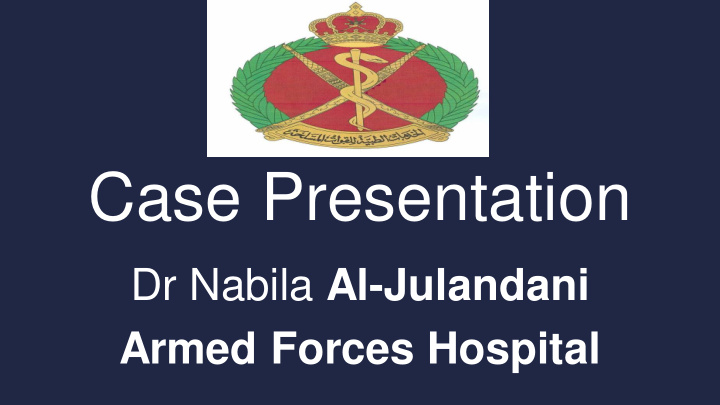



Case Presentation Dr Nabila Al-Julandani Armed Forces Hospital
Case • 39 years old lady • Present in July 2016 : history of epigastric pain, nausea, weight loss and anemia. • Past history: – In February 2016: radical hysterectomy for cervical cancer. • Family history: – Positive for uterine and gastrointestinal carcinoma.
Case • CT scan abdomen: – Large irregular fungating mass of the gastric fundus infiltrating the splenic hilum, splenic vessels with large area of lower pole splenic infarction. – The gastroesophageal junction looks unremarkable. – No significant lymphadenopathy or peritoneal deposits. – No liver or lung metastasis.
Gross • Gastresophagectomy with enblock resection of spleen, distal pancreas and part of diaphragm. • Polypoid ulcerated tumor in the fundus and upper body. • The tumor was 5 cm from proximal margin. • The tumor infiltrates spleen and diaphragm.
Gastroesophagectomy with enblock resection of spleen , distal pancreas and diaphragm
MICROSCOPY
Summary • Squamous cell carcinoma. • No intestinal or squamous metaplasia • 30 lymph nodes with no evidence of metastatic tumor. • Perineural and vascular invasion present. • Proximal and distal resection margins are free of tumor. • Gastroesophageal junction is free of tumor. • Tumor infiltrates spleen, diaphragm and peripancreatic tissue.
Diagnosis • Moderately to poorly differentiated squamous cell carcinoma involving the stomach ( fundus and upper body ), spleen and diaphragm. • Primary ?? Metastasis ??
• Primary gastric SCC : – Nests of squamous epithelium in gastric mucosa – Squamous metaplasia of gastric mucosa. – Multipotent stem cell in gastric mucosa. – Squamous differentiation of pre-existing adenocarcinoma.
Cervical Cancer
IMMUNOHISTOCHEMISTRY
• The tumor cells positive for ▪ Ck5/6 ▪ P16 ▪ p63 ▪ p53
Diagnosis • Metastatic moderately to poorly differentiated squamous cell carcinoma from cervix to stomach, spleen and diaphragm. • Stage ??
• Cervical squamous cell carcinoma, ( FIGO stage IV )
Discussion • Gastric cancer is the fourth most common type of malignancy. • Adenocarcinoma is the most common histologic type ( >90% ) . • Either metastatic or primary squamous cell carcinoma in the stomach is extermely rare.
Discussion • Very few cases reported in literature. • Pure primary squamous cell carcinoma of stomach is very rare. • Common in elderly • M:F ratio is 5:1. • The primary is more common than secondary.
• Stomach is an unusual site for metastasis. • The primary site: esophagus, skin, lung and breast. • Most Metastatic SCC to stomach are from lung primary.
Discussion • In cervix, SCC accounts to 80-85%. • It can occurs at any age. • Most common metastatic sites - direct extension to contiguous structures. • 50% of stage IV - distant metastasis. • Common sites : liver, lung, bone marrow. • GIT is 8%.
Discussion • Common sites : rectum. • Gastric lesion : <2%. • Spread: lymphatics (para-aortic or mesenteric nodes to gastric serosa. o blood stream. o Peritoneal seedlings. • Splenic metastasis – multiple organ mets.
Conclusion • Primary and secondary SCC of stomach is extremely rare. • Extra-pelvic spread of cervical SCC to the stomach is uncommon. • Accurate recognition of such unusual pattern of metastasis is important for therapeutic decision.
Recommend
More recommend